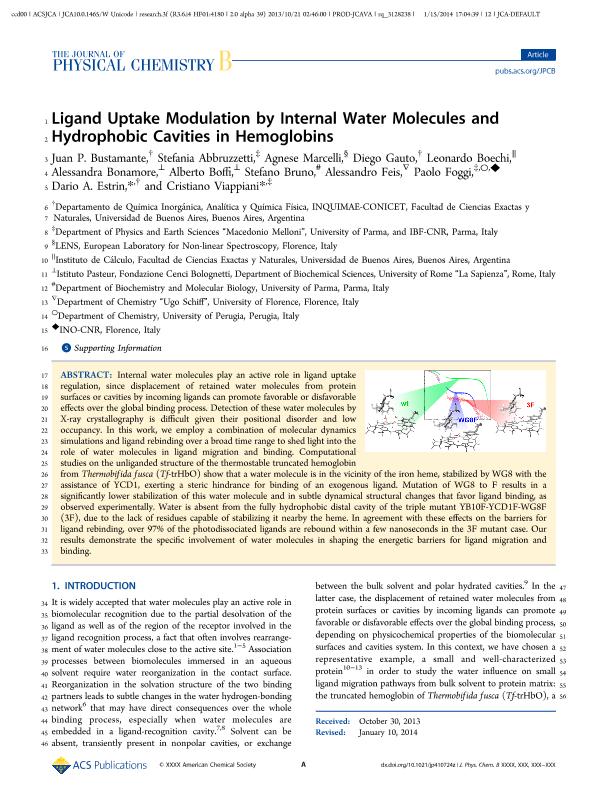Mostrar el registro sencillo del ítem
dc.contributor.author
Bustamante, Juan Pablo

dc.contributor.author
Abbruzzetti, Stefania
dc.contributor.author
Marcelli, Agnese
dc.contributor.author
Gauto, Diego Fernando

dc.contributor.author
Boechi, Leonardo

dc.contributor.author
Bonamore, Alessandra
dc.contributor.author
Boffi, Alberto
dc.contributor.author
Bruno, Stefano
dc.contributor.author
Feis, Alessandro
dc.contributor.author
Foggi, Paolo
dc.contributor.author
Estrin, Dario Ariel

dc.contributor.author
Viappiani, Cristiano
dc.date.available
2017-12-21T20:06:01Z
dc.date.issued
2014-01
dc.identifier.citation
Viappiani, Cristiano; Estrin, Dario Ariel; Foggi, Paolo; Feis, Alessandro; Bruno, Stefano; Boffi, Alberto; et al.; Ligand Uptake Modulation by Internal Water Molecules and Hydrophobic Cavities in Hemoglobins; American Chemical Society; Journal of Physical Chemistry B; 118; 5; 1-2014; 1234-1245
dc.identifier.issn
1520-6106
dc.identifier.uri
http://hdl.handle.net/11336/31289
dc.description.abstract
Internal water molecules play an active role in ligand uptake regulation, since displacement of retained water molecules from protein surfaces or cavities by incoming ligands can promote favorable or disfavorable effects over the global binding process. Detection of these water molecules by X-ray crystallography is difficult given their positional disorder and low occupancy. In this work, we employ a combination of molecular dynamics simulations and ligand rebinding over a broad time range to shed light into the role of water molecules in ligand migration and binding. Computational studies on the unliganded structure of the thermostable truncated hemoglobin from Thermobifida fusca (Tf-trHbO) show that a water molecule is in the vicinity of the iron heme, stabilized by WG8 with the assistance of YCD1, exerting a steric hindrance for binding of an exogenous ligand. Mutation of WG8 to F results in a significantly lower stabilization of this water molecule and in subtle dynamical structural changes that favor ligand binding, as observed experimentally. Water is absent from the fully hydrophobic distal cavity of the triple mutant YB10F-YCD1F-WG8F (3F), due to the lack of residues capable of stabilizing it nearby the heme. In agreement with these effects on the barriers for ligand rebinding, over 97% of the photodissociated ligands are rebound within a few nanoseconds in the 3F mutant case. Our results demonstrate the specific involvement of water molecules in shaping the energetic barriers for ligand migration and binding.
dc.format
application/pdf
dc.language.iso
eng
dc.publisher
American Chemical Society

dc.rights
info:eu-repo/semantics/openAccess
dc.rights.uri
https://creativecommons.org/licenses/by-nc-sa/2.5/ar/
dc.subject
Truncated Hemoglobin
dc.subject
Ligand Migration
dc.subject
Molecular Dynamics
dc.subject.classification
Otras Ciencias Biológicas

dc.subject.classification
Ciencias Biológicas

dc.subject.classification
CIENCIAS NATURALES Y EXACTAS

dc.title
Ligand Uptake Modulation by Internal Water Molecules and Hydrophobic Cavities in Hemoglobins
dc.type
info:eu-repo/semantics/article
dc.type
info:ar-repo/semantics/artículo
dc.type
info:eu-repo/semantics/publishedVersion
dc.date.updated
2017-12-12T18:51:34Z
dc.journal.volume
118
dc.journal.number
5
dc.journal.pagination
1234-1245
dc.journal.pais
Estados Unidos

dc.description.fil
Fil: Bustamante, Juan Pablo. Consejo Nacional de Investigaciones Científicas y Técnicas. Oficina de Coordinación Administrativa Ciudad Universitaria. Instituto de Química, Física de los Materiales, Medioambiente y Energía. Universidad de Buenos Aires. Facultad de Ciencias Exactas y Naturales. Instituto de Química, Física de los Materiales, Medioambiente y Energía; Argentina
dc.description.fil
Fil: Abbruzzetti, Stefania. Università di Parma; Italia
dc.description.fil
Fil: Marcelli, Agnese. European Laboratory for Non-linear Spectroscopy; Italia
dc.description.fil
Fil: Gauto, Diego Fernando. Consejo Nacional de Investigaciones Científicas y Técnicas. Oficina de Coordinación Administrativa Ciudad Universitaria. Instituto de Química, Física de los Materiales, Medioambiente y Energía. Universidad de Buenos Aires. Facultad de Ciencias Exactas y Naturales. Instituto de Química, Física de los Materiales, Medioambiente y Energía; Argentina
dc.description.fil
Fil: Boechi, Leonardo. Universidad de Buenos Aires. Facultad de Ciencias Exactas y Naturales. Instituto de Cálculo; Argentina. Consejo Nacional de Investigaciones Científicas y Técnicas; Argentina
dc.description.fil
Fil: Bonamore, Alessandra. Instituto de Investigaciones Universitarias Roma la Sapienza; Italia
dc.description.fil
Fil: Boffi, Alberto. Instituto de Investigaciones Universitarias Roma la Sapienza; Italia
dc.description.fil
Fil: Bruno, Stefano. Università di Parma; Italia
dc.description.fil
Fil: Feis, Alessandro. Universita Degli Studi Di Firenze; Italia
dc.description.fil
Fil: Foggi, Paolo. Università di Perugia; Italia. INO-CNR; Italia
dc.description.fil
Fil: Estrin, Dario Ariel. Consejo Nacional de Investigaciones Científicas y Técnicas. Oficina de Coordinación Administrativa Ciudad Universitaria. Instituto de Química, Física de los Materiales, Medioambiente y Energía. Universidad de Buenos Aires. Facultad de Ciencias Exactas y Naturales. Instituto de Química, Física de los Materiales, Medioambiente y Energía; Argentina
dc.description.fil
Fil: Viappiani, Cristiano. Università di Parma; Italia
dc.journal.title
Journal of Physical Chemistry B

dc.relation.alternativeid
info:eu-repo/semantics/altIdentifier/doi/http://dx.doi.org/10.1021/jp410724z
dc.relation.alternativeid
info:eu-repo/semantics/altIdentifier/url/http://pubs.acs.org/doi/10.1021/jp410724z
Archivos asociados
